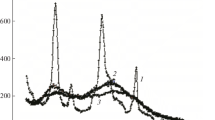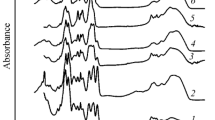Abstract
Chitin–protein interfaces exist in many biological materials such as cuticles of insects and crustaceans, which are main commercial sources of chitin fiber. In industrial processing, the extraction of chitin from these sources is achieved via acidic and alkaline treatments. As the acidity changes, the ionizable groups of protein undergo protonation/deprotonation, which may vary the mechanical properties of chitin–protein interface. In order to study the effect of acidity on this interface, we perform a series of molecular dynamics simulations and measure the adhesion strength between chitin and a short peptide sequence under both acidic and alkaline conditions, where the two termini are modified to accommodate the environment. The results indicate that the protonation state of terminus has a significant influence on the adhesion with chitin. Based on our simple model and its results, we analyze the roles of termini in the formation of hydrogen bonds and elucidate some atomistic mechanisms behind the acidity effect on chitin–protein interface, which may spotlight the engineering on biological materials with similar interfaces.









Similar content being viewed by others
References
Tharanathan, R. N., & Kittur, F. S. (2003). Chitin—the undisputed biomolecule of great potential. Critical Reviews in Food Science and Nutrition 43(1): 61-87.
Dunlop, J. W., & Fratzl, P. (2013). Multilevel architectures in natural materials. Scripta Materialia, 68(1), 8–12.
Ravi Kumar, M. N. (2000). A review of chitin and chitosan applications. Reactive and Functional Polymers, 46(1), 1–27.
Vincent, J. F., & Wegst, U. G. (2004). Design and mechanical properties of insect cuticle. Arthropod Structure & Development, 33(3), 187–199.
Nikolov, S., Petrov, M., Lymperakis, L., Friák, M., Sachs, C., Fabritius, H.-O., et al. (2010). Revealing the design principles of high-performance biological composites using Ab initio and multiscale simulations: the example of lobster cuticle. Advanced Materials, 22(4), 519–526.
Krajewska, B. (2004). Application of chitin- and chitosan-based materials for enzyme immobilizations: a review. Enzyme and Microbial Technology, 35(2), 126–139.
Xu, Z., & Buehler, M. J. (2009). Hierarchical graphene nanoribbon assemblies feature unique electronic and mechanical properties. Nanotechnology, 20(37), 375704.
Qin, Z., & Buehler, M. J. (2010). Cooperative deformation of hydrogen bonds in beta-strands and beta-sheet nanocrystals. Physical Review E, 82(6), 061906.
Keten, S., & Buehler, M. J. (2008). Geometric confinement governs the rupture strength of H-bond assemblies at a critical length scale. Nano Letters, 8(2), 743–748.
Lau, D., Büyüköztürk, O., Buehler, M. J. (2012). Characterization of the intrinsic strength between epoxy and silica using a multiscale approach. Journal of Materials Research, 27(14), 1787–1796.
Qin, Z., & Buehler, M. (2012). Molecular mechanics of dihydroxyphenylalanine at a silica interface. Applied Physics Letters, 101(8), 083702.
Jin, K., Feng, X., Xu, Z. (2013). Mechanical properties of chitin-protein interfaces: a molecular dynamics study. BioNanoScience 3(3): 312-320.
Miserez, A., Rubin, D., Waite, J. H. (2010). Cross-linking chemistry of squid beak. Journal of Biological Chemistry, 285(49), 38115–38124.
Gronau, G., Qin, Z., Buehler, M. J. (2013). Effect of sodium chloride on the structure and stability of spider silk’s N-terminal protein domain. Biomaterials Science, 1(3), 276–284.
Waite, J. H., & Broomell, C. C. (2012). Changing environments and structure–property relationships in marine biomaterials. The Journal of Experimental Biology, 215(6), 873–883.
Börjesson, U., & Hünenberger, P. H. (2001). Explicit-solvent molecular dynamics simulation at constant pH: methodology and application to small amines. The Journal of Chemical Physics, 114, 9706.
Wallace, J. A., & Shen, J. K. (2011). Continuous constant pH molecular dynamics in explicit solvent with pH-based replica exchange. Journal of Chemical Theory and Computation, 7(8), 2617–2629.
Rinaudo, M. (2006). Chitin and chitosan: properties and applications. Progress in Polymer Science, 31(7), 603–632.
Cranford, S. W., Ortiz, C., Buehler, M. J. (2010). Mechanomutable properties of a PAA/PAH polyelectrolyte complex: rate dependence and ionization effects on tunable adhesion strength. Soft Matter, 6(17), 4175–4188.
Petrov, M., Lymperakis, L., Friák, M., Neugebauer, J. (2013). Ab Initio based conformational study of the crystalline α-chitin. Biopolymers, 99(1), 22–34.
Haynes, W. M. (2012). CRC handbook of chemistry and physics. Boca Raton, Florida: CRC press.
Plimpton, S. (1995). Fast parallel algorithms for short-range molecular dynamics. Journal of Computational Physics, 117(1), 1–19.
Huang, J., & MacKerell, A. D. (2013). CHARMM36 all-atom additive protein force field: validation based on comparison to NMR data. Journal of Computational Chemistry, 34(25), 2135–2145.
Guvench, O., Mallajosyula, S. S., Raman, E. P., Hatcher, E., Vanommeslaeghe, K., Foster, T. J., et al. (2011). CHARMM additive all-atom force field for carbohydrate derivatives and its utility in polysaccharide and carbohydrate–protein modeling. Journal of Chemical Theory and Computation, 7(10), 3162–3180.
Ryckaert, J.-P., Ciccotti, G., Berendsen, H. J. (1977). Numerical integration of the Cartesian equations of motion of a system with constraints: molecular dynamics of <i>n</i>−alkanes. Journal of Computational Physics, 23(3), 327–341.
Toukmaji, A. Y., & Board, J. A., Jr. (1996). Ewald summation techniques in perspective: a survey. Computer Physics Communications, 95(2), 73–92.
Hestenes, M. R., & Stiefel, E. (1952). Methods of conjugate gradients for solving linear systems. Journal of Research of the National Bureau of Standards, 49(6), 409–436.
Beckham, G. T., & Crowley, M. F. (2011). Examination of the α-chitin structure and decrystallization thermodynamics at the nanoscale. The Journal of Physical Chemistry B, 115(15), 4516–4522.
Jorgensen, W. L., Chandrasekhar, J., Madura, J. D., Impey, R. W., Klein, M. L. (1983). Comparison of simple potential functions for simulating liquid water. The Journal of Chemical Physics, 79, 926.
Miller, T., Eleftheriou, M., Pattnaik, P., Ndirango, A., Newns, D., Martyna, G. (2002). Symplectic quaternion scheme for biophysical molecular dynamics. Journal of Chemical Physics, 116(20), 8649–8659.
Taylor, R. D., Jewsbury, P. J., Essex, J. W. (2002). A review of protein-small molecule docking methods. Journal of Computer-Aided Molecular Design, 16(3), 151–166.
Erickson, J. A., Jalaie, M., Robertson, D. H., Lewis, R. A., Vieth, M. (2004). Lessons in molecular recognition: the effects of ligand and protein flexibility on molecular docking accuracy. Journal of Medicinal Chemistry, 47(1), 45–55.
Büyüköztürk, O., Buehler, M. J., Lau, D., Tuakta, C. (2011). Structural solution using molecular dynamics: fundamentals and a case study of epoxy-silica interface. International Journal of Solids and Structures, 48(14), 2131–2140.
Park, S., Khalili-Araghi, F., Tajkhorshid, E., Schulten, K. (2003). Free energy calculation from steered molecular dynamics simulations using Jarzynski’s equality. The Journal of Chemical Physics, 119, 3559.
Humphrey, W., Dalke, A., Schulten, K. (1996). VMD: visual molecular dynamics. Journal of Molecular Graphics, 14(1), 33–38.
Liphardt, J., Dumont, S., Smith, S. B., Tinoco, I., Bustamante, C. (2002). Equilibrium information from nonequilibrium measurements in an experimental test of Jarzynski’s equality. Science, 296(5574), 1832–1835.
Reed, A. E., Curtiss, L. A., Weinhold, F. (1988). Intermolecular interactions from a natural bond orbital, donor-acceptor viewpoint. Chemical Reviews, 88(6), 899–926.
Miserez, A., & Guerette, P. A. (2012). Integrating materials and life sciences toward the engineering of biomimetic materials. JOM, 64(4), 494–504.
Acknowledgments
The authors are grateful to the support from Croucher Foundation through the Start-up Allowance for Croucher Scholars with the Grant No. 9500012 and the support from the Research Grants Council (RGC) in Hong Kong through the Early Career Scheme (ECS) with the Grant No. 139113.
Author information
Authors and Affiliations
Corresponding author
Rights and permissions
About this article
Cite this article
Yu, Z., Xu, Z. & Lau, D. Effect of Acidity on Chitin–Protein Interface: A Molecular Dynamics Study. BioNanoSci. 4, 207–215 (2014). https://doi.org/10.1007/s12668-014-0138-5
Published:
Issue Date:
DOI: https://doi.org/10.1007/s12668-014-0138-5




